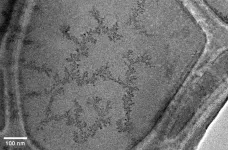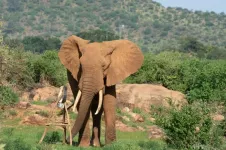(Press-News.org) March 26, 2025
AMHERST, Mass. – Many native plants in the U.S. cannot possibly move themselves fast enough to avoid climate-change driven extinction. If these native plants are going to have any chance of surviving into the future, they’ll need human help to move into adjacent areas, a process known as “managed relocation.” And yet, there’s no guarantee that a plant will thrive in a new area. Furthermore, movement of introduced plants, albeit over much larger distances, is exactly how the problem of invasive species began—think of kudzu-choked forests, wetlands taken over by purple loosestrife or fields ringed by Japanese honeysuckle. Thanks to new research from a pair of ecologists at the University of Massachusetts Amherst, we now have a detailed sense of which plant characteristics will help ensure successful relocation while minimizing the risk that the plant causes unwanted ecological harm.
“We know that, because of climate, native species need to move,” says Thomas Nuhfer, lead author of the paper that appeared recently in Global Change Biology and a graduate student in UMass Amherst’s program in organismic and evolutionary biology. “But many of the people working to manage invasive plant species have real concerns about unwittingly contributing to the problem if we start moving native species around.”
“We’ve made the mistake of introducing invasive species so many times in the past,” says Bethany Bradley, professor of environmental conservation at UMass and the paper’s senior author, “and we don’t want to keep making that mistake. But in a changing climate, doing nothing might do even more harm.”
Bradley’s lab has previously shown that confronting the epidemic of invasive species is one of the best ways to prepare, at the local level, for climate change, that numbers of invasive plants are increasing exponentially and, crucially, that plants and animals need to be shifting their ranges by 3.25 kilometers per year just to keep up with the increasing temperatures and associated climactic shifts.
So how to help plants move successfully without risking them causing harm?
“We often use specific plant characteristics—like how quickly a plant grows, how long it flowers or whether its seeds can be spread by the wind—to determine its risk of becoming invasive,” says Nuhfer. “But these are also traits that could help a native species to survive in a new environment.”
To disentangle which traits could lead to success and which to ecological disaster, Nuhfer and Bradley surveyed a wide variety of papers from restoration and invasion ecology, as well as the plant risk assessments and frameworks that managers in the field often use. What they found is that the same traits help plants to establish themselves in a new location, whether they are invasive species or relocation candidates. However, as plants try to spread and particularly in the impact they have on their new ecologies, the traits for invasives and successful relocation diverge widely.
What this means is that a specific trait, like a high metabolic rate, is helpful when a plant is trying to establish itself, regardless of if the species is native or invasive. However, there are certain traits, like having a large size, that predispose a plant not only to establishing successfully, but spreading wildly and leaving an outsized impact on its new environment.
Additionally, there are some traits, like toxicity, which can help identify poor native species candidates for relocation - traits that don’t really help the plants establish, but do help them spread or cause harm.
This suggests that there are certain traits associated with invasiveness, especially those that aid in establishing a plant in a new place, that we should actually be looking for in native species to ensure their survival. Instead of filtering out those traits, risk assessments should focus on traits like having water dispersed seeds or toxicity, which don’t help plants establish much but do help them spread and cause harm.
“Many of the current risk assessments that managers are using in the field are so risk-averse as to guarantee that managed relocation will fail,” says Bradley.
“And if the relocation fails,” adds Nuhfer, “then we’ve wasted all sorts of resources and haven’t helped native plants persist.”
This research was supported by the U.S. Geological Survey Northeast Climate Adaptation Science Center.
About the University of Massachusetts Amherst
The flagship of the commonwealth, the University of Massachusetts Amherst is a nationally ranked public land-grant research university that seeks to expand educational access, fuel innovation and creativity and share and use its knowledge for the common good. Founded in 1863, UMass Amherst sits on nearly 1,450-acres in scenic Western Massachusetts and boasts state-of-the-art facilities for teaching, research, scholarship and creative activity. The institution advances a diverse, equitable, and inclusive community where everyone feels connected and valued—and thrives, and offers a full range of undergraduate, graduate and professional degrees across 10 schools and colleges and 100 undergraduate majors.
Contacts: Thomas Nuhfer, tnuhfer@umass.edu
Bethany Bradley, bbradley@eco.umass.edu
Daegan Miller, drmiller@umass.edu
END
If native plants are going to survive climate change, they need our help to move—here’s how to do it safely
UMass Amherst researchers uncover traits that can help plants succeed in new environments while also guarding against invasiveness
2025-03-26
ELSE PRESS RELEASES FROM THIS DATE:
Blue pigment improves foundation makeup shades for dark skin
2025-03-26
SAN DIEGO, March 26, 2025 — On the shelves of makeup counters and drugstores sits an array of foundations in various olive, ivory and fair shades. But for people with darker skin tones, finding the right foundation shade can be a challenge. Dark foundations on the market often fall flat, appearing gray-like once applied on the skin. But now, researchers report a blue cosmetic color additive that gives these foundations the warmth and depth they currently lack.
Gabriella Baki, associate professor of pharmaceutics and director of the cosmetic science and formulation design undergraduate program at the University of ...
A safe nuclear battery that could last a lifetime
2025-03-26
SAN DIEGO, March 26, 2025 — Sometimes cell phones die sooner than expected or electric vehicles don’t have enough charge to reach their destination. The rechargeable lithium-ion (Li-ion) batteries in these and other devices typically last hours or days between charging. However, with repeated use, batteries degrade and need to be recharged more frequently. Now, researchers are considering radiocarbon as a source for safe, small and affordable nuclear batteries that could last decades or longer without charging.
Su-Il In, a professor at Daegu Gyeongbuk Institute of Science & Technology, will present his results at the spring meeting of the American Chemical ...
Making sturdy, semi-transparent wood with cheap, natural materials
2025-03-26
SAN DIEGO, March 26, 2025 — Can you imagine a smartphone with a wooden touchscreen? Or a house with wooden windows? Probably not — unless you’ve heard of transparent wood. Made by modifying wood’s natural structure, this material has been proposed as a sturdy, eco-friendly plastic alternative. But wood’s biodegradability is often sacrificed in the process. Researchers are hoping to change that by creating transparent woods from almost entirely natural materials and making them electrically conductive.
The researchers will present their results at the spring ...
Adulting is hard on the heart: Teen to young adulthood is a critical time to address risk
2025-03-26
Statement Highlights:
By age 18, many adolescents have already developed heart disease risk factors, such as high blood pressure, obesity, high cholesterol or Type 2 diabetes, and a growing number of younger adults are experiencing adverse cardiovascular events.
Numerous social determinants of health and developmental and life changes impact cardiovascular risk as young people progress from their teens to their mid-20s.
The statement describes the challenges and opportunities for easing the transition ...
Study shows link between the start of the working day and time preferences
2025-03-26
Those who start work earlier express more discomfort with the seasonal time change. This is the main conclusion of a study that the lecturers at the University of Santiago de Compostela (USC) and the University of Seville (US), Jorge Mira Pérez and José María Martín Olalla, have just published in the journal Chronobiology International, in which they analyse in detail the results of the public consultation organised by the European Commission in 2018 in the then 28 member states, which ...
Scientists discovered chemical oscillations in palladium nanoparticles, paving the way for recycling precious metal catalysts
2025-03-26
Scientists have for the first time filmed the real-time growth and contraction of Palladium nanoparticles, opening new avenues for utilising and recycling precious metal catalysts.
Researchers at the University of Nottingham’s School of Chemistry used transmission electron microscopy (TEM) to observe the complete lifecycle of palladium nanoparticles in a liquid environment, from nucleation through growth to dissolution, with the entire cycle repeating multiple times. This study has been published today in Nanoscale.
One of the most important applications of metal nanoparticles is in catalysis, which forms a backbone of chemical industries. Dr Jesum Alves ...
Tadpoles try to flee dangerous virus in their pond by growing much faster than normal
2025-03-26
The world’s amphibians are in trouble. Because of their sensitivity to climate change, habitat loss, and pollution, they may be the canary in the coalmine for the nascent anthropogenic mass extinction. Approximately 200 amphibian species have become extinct since the 1970s, and the International Union for the Conservation of Nature estimates that 34% of the 7,296 known remaining species are likewise at risk.
Another reason why amphibians are vulnerable is their susceptibility to disease. An emerging, potentially deadly disease of frogs and salamanders is ranavirus, a genus of at least seven species within the family Iridoviridae. Ranavirus can rapidly jump ...
Build it and they shall come
2025-03-26
Designing walkable neighborhoods has gained attention as a method to increase physical activity among urban populations. Moreover, highly walkable areas stimulate increased neighborhood retail sales, higher property values, and greater urban sustainability. However, only limited methods are available for improving walkability in the urban centers of highly motorized suburban cities. In the urban areas of suburban cities, increasing land-use diversity by opening a multifunctional facility is considered one of the most effective strategies for an architecture-scale intervention.
Dr. Haruka Kato, ...
How elephants plan their journeys: New study reveals energy-saving strategies
2025-03-26
UNDER EMBARGO UNTIL 05:01 GMT / 01:01 ET WEDNESDAY 26 MARCH 2025
How elephants plan their journeys: New study reveals energy-saving strategies
A new study has revealed that African Elephants have an extraordinary ability to meet their colossal food requirements as efficiently as possible. Data from over 150 elephants demonstrated that these giants plan their journeys based on energy costs and resource availability. The findings – published today (26 March) in the Journal of Animal Ecology– could provide crucial information to help protect these iconic animals and their habitats.
Being an elephant is no easy task. As massive herbivores weighing several ...
New study challenges the ‘monogamy-superiority myth’, as non-monogamous people report just as happy relationships and sex lives
2025-03-26
Monogamous and non-monogamous individuals report similar levels of satisfaction in both their relationships and sex lives, according to a comprehensive new meta-analysis.
Published today in The Journal of Sex Research, the peer-reviewed study debunks the prevailing belief that monogamous relationships – defined as exclusive romantic and sexual commitment to one partner – are inherently superior in fostering fulfilling relationships compared to alternative structures.
While monogamy has been the predominant type of relationship in much of recent Western history, many individuals choose alternative structures. Non-monogamy includes various ...
LAST 30 PRESS RELEASES:
Deep neural networks enable accurate pricing of American options under stochastic volatility
Collective risk resonance in Chinese stock sectors uncovered through higher-order network analysis
Does CPU impact systemic risk contributions of Chinese sectors? Evidence from mixed frequency methods with asymmetric tail long memory
General intelligence framework to predict virus adaptation based on a genome language model
Antibiotic resistance is ancient, ecological, and deeply connected to human activity, new review shows
Vapes, pouches, heated tobacco, shisha, cigarettes: nicotine in all forms is toxic to the heart and blood vessels
From powder to planet: University of Modena engineers forge a low-carbon future for advanced metal manufacturing
Super strain-resistant superconductors
Pre-school health programme does not improve children’s diet or physical activity, prompting call for policy changes, study finds
Autumn clock change linked to reduction in certain health conditions
AI images of doctors can exaggerate and reinforce existing stereotypes
Where medicine meets melody – how lullabies help babies and parents in intensive care
We may never be able to tell if AI becomes conscious, argues philosopher
AI video translation shows promise but humans still hold the edge
Deep ocean earthquakes drive Southern Ocean’s massive phytoplankton blooms, study finds
Without campus leftovers to pick through, the beaks of this bird changed shape during the pandemic
High-dose antibiotic does not reduce mortality in tuberculous meningitis
How many insects fly in the sky above the USA?
Could cheese protect your brain health?
Who faces more difficulty recovering from stroke?
Colliding galaxies create the brightest, fastest growing black holes at their center
New BrainHealth research reveals tradeoffs on sleep with cannabis use for chronic pain
Aging-US now on ResearchGate, enhancing visibility for authors and readers
'Molecular glue' stabilizes protein that inhibits development of non-small cell lung cancer
Mount Sinai Health System is recognized in 2025 Chime Digital Health Most Wired survey
From prey to predator: How carnivores spread beneficial fungi
Menopause symptoms may be frequent and have negative effects, according to female endurance athletes
US Congressmembers’ responses on X to mass shooting events differ along party lines
KAIST-UEL team develops “origami” airless wheel to explore lunar caves
Individual genetic differences render some therapies ineffective
[Press-News.org] If native plants are going to survive climate change, they need our help to move—here’s how to do it safelyUMass Amherst researchers uncover traits that can help plants succeed in new environments while also guarding against invasiveness






